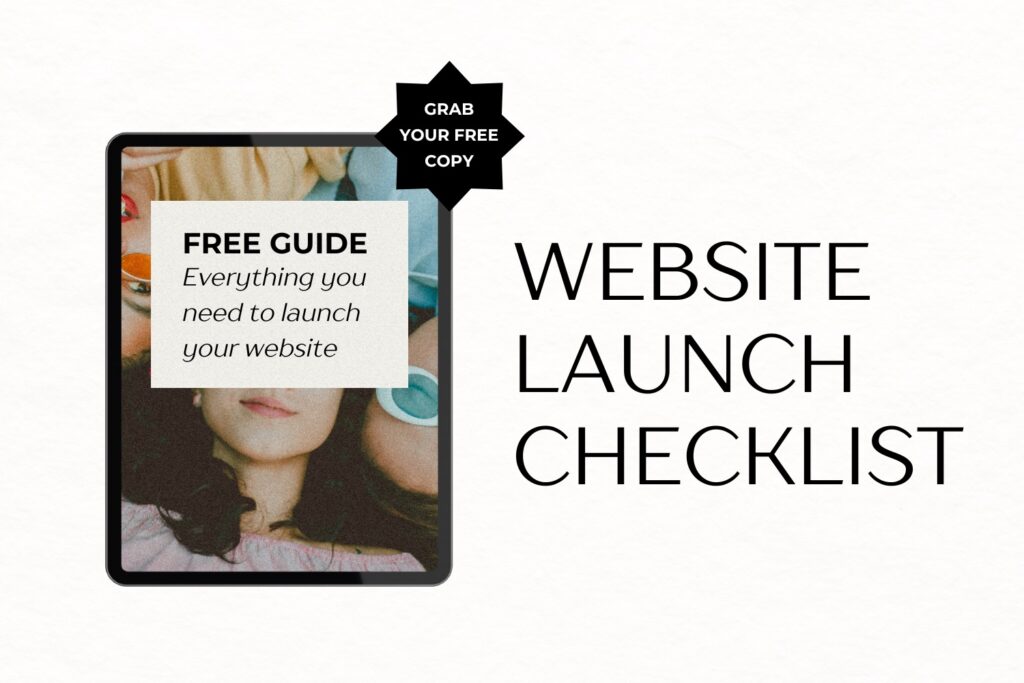Launching a website is an exciting milestone, but it requires careful planning and execution to ensure its success. To help you navigate through the process smoothly, we’ve compiled the ultimate website launch checklist. This comprehensive checklist covers everything you need to consider before, during, and after your website launch, ensuring a seamless user experience and optimal performance. So, let’s dive in and ensure your website launch is a resounding success!
Needless to say, when you work with me, every single one of these is baked into your custom plan.
But first things first, grab your free website launch checklist here >>>

Your Goals and Objectives:
This is the very first thing I do when I onboard a new client. Before diving into the website launch process, it’s crucial to define your goals and objectives. Determine what you want to achieve with your website, whether it’s generating leads, driving sales, increasing brand awareness, or providing valuable resources. Clearly identifying your goals will help you make informed decisions throughout the launch process.
Market Research:
I’m sure you’ve heard every single marketing guru or web designer say this. I know, it’s cliche for a reason. But as overused as this phrase is, understanding your target audience and market is vital for a successful website launch. Conduct market research to identify your audience’s needs, preferences, and pain points. This knowledge will shape your website’s design, content, and overall user experience, ultimately increasing your chances of conversion.
Keyword Research:
To improve your website’s search engine visibility, we need comprehensive keyword research. Identify relevant keywords and incorporate them strategically into your website’s content, meta tags, and descriptions. This will help attract organic traffic and increase your chances of ranking higher in search engine results.
Information Architecture:
Information architecture is the (logical) organization of information on your website. All things ranging from your main navigation, to the way information is presented on each page, to the footer area also constitute to the entire information architecture on your website. Your designer should work with you to create an intuitive and user-centric information architecture for your website. Organize content logically and ensure easy navigation throughout the site. Develop a clear and concise menu structure that guides users seamlessly to their desired information or products.
Engaging Content:
Develop a content strategy that aligns with your goals and resonates with your target audience. Plan and create high-quality, engaging, and relevant content that educates, informs, and captivates your users. Incorporate various content formats such as blog posts, videos, infographics, and case studies to cater to different user preferences. I offer this as a paid addon for my clients.
User Interface Design:
Invest in professional web design services or leverage user-friendly website builders (like Showit if you’re DIYing) to create a captivating user interface. Design a visually appealing website that aligns with your brand identity, effectively communicates your message, and provides an enjoyable browsing experience. Pay attention to typography, color schemes, and visual hierarchy to ensure easy readability and an aesthetically pleasing design.
Mobile Responsiveness:
In today’s mobile-driven world, mobile responsiveness is non-negotiable. Optimize your website to provide a seamless experience across all devices and screen sizes. Test your website’s responsiveness using different mobile devices and ensure that it adapts flawlessly to varying resolutions and orientations.
Search Engine Optimization (SEO) Best Practices:
Boost your website’s visibility on search engines by implementing SEO best practices. Optimize your website’s on-page elements, including meta tags, headings, URLs, and alt tags. Leverage relevant keywords, improve site speed, and ensure proper website indexing. Regularly monitor and analyze your website’s performance using SEO tools to make data-driven improvements.
Cross-Browser Compatibility:
Don’t overlook cross-browser compatibility. Test your website’s functionality and appearance across different browsers (e.g., Chrome, Firefox, Safari, Internet Explorer) to ensure a consistent experience for all users. Address any compatibility issues promptly to avoid frustrating users and potential conversion loss.
Quality Assurance (QA) Testing:
Before launching your website, your web designer should perform comprehensive quality assurance testing. Check for broken links, missing images, typographical errors, and any functional issues. Test all interactive elements, forms, shopping carts, and third-party integrations. Ensure that the website functions flawlessly across all pages and devices.
Website Speed and Performance:
Website speed plays a crucial role in user experience and search engine rankings. Optimize your website’s performance by compressing images, minimizing code, leveraging caching techniques, and choosing a reliable hosting provider. Regularly monitor website speed and make necessary optimizations to provide a fast and seamless browsing experience.
Web Analytics:
Implement a robust web analytics solution, such as Google Analytics, to track and measure your website’s performance. Set up conversion tracking, goals, and funnels to gain insights into user behavior, traffic sources, and conversion rates. Regularly review analytics data to identify areas for improvement and make data-driven decisions.
Social Media Sharing and Follow Buttons:
Leverage the power of social media by integrating social sharing buttons and follow buttons on your website. This allows users to easily share your content across various platforms, increasing visibility and potential conversions. Displaying follower counts or social proof can also enhance credibility and trust.
Conversion Tracking and Goal Monitoring:
Define your conversion goals and set up conversion tracking to monitor their performance. Track key metrics such as form submissions, newsletter sign-ups, purchases, or any other desired actions. This data will help you identify areas for improvement and optimize your website’s conversion funnel.
Meta Tags and Descriptions:
Craft compelling meta tags and descriptions for each page of your website. Optimize them by incorporating relevant keywords and accurately describing the content. Well-crafted meta tags can improve click-through rates in search engine results, driving more traffic to your website.
Security:
Website security is paramount to protect user data and build trust. Implement SSL encryption to secure user interactions and ensure secure transactions. Regularly update your website’s software and plugins, use strong passwords, and conduct security audits to identify and address vulnerabilities.
Landing Pages Optimization:
If you’re running specific marketing campaigns, create dedicated landing pages. Optimize these pages to align with your campaign goals and provide a focused and persuasive message. Implement clear and compelling CTAs to encourage conversions and track campaign-specific metrics.
404 Error Pages:
Even with thorough testing, users may encounter 404 error pages. Customize these pages to provide helpful information and guide users back to relevant content or a search option. Maintain your branding and provide alternative resources or suggestions to keep users engaged and prevent them from leaving your site.
Email Marketing Integration:
If you plan to use email marketing to nurture leads and drive conversions, configure your website to integrate with your chosen email marketing platform. Set up opt-in forms, autoresponders, and lead capture mechanisms to seamlessly connect with your audience and build effective email marketing campaigns.
Local Search Optimization (if applicable):
If your business has a physical location, optimize your website for local search. Claim your business on Google My Business, Bing Places, and other local directories. Ensure accurate and consistent NAP (name, address, phone number) information across all platforms. Encourage customers to leave reviews, and respond to them promptly to build local credibility.
Backup and Recovery Plan:
Prepare for unforeseen circumstances by implementing a reliable backup and recovery plan. Regularly backup your website’s files and databases to an off-site location. Familiarize yourself with the recovery process to quickly restore your website in case of data loss or system failures.
Optimize Robots.txt and XML Sitemap:
Ensure search engine crawlers can access and index your website properly. Create a robots.txt file to provide instructions on which pages should or should not be crawled. Generate an XML sitemap to facilitate search engine indexing and ensure all relevant pages are discovered and ranked appropriately.
Website Monitoring and Alerts:
Implement website monitoring tools to track uptime, performance, and security. Configure alerts to receive notifications in case of website downtime, unusual traffic spikes, or security breaches. Prompt alerts allow you to address issues swiftly, minimizing potential disruptions and ensuring a positive user experience.
Launch Announcement and Plan:
Create a launch announcement or press release to generate buzz and inform your audience about your new website. Plan your launch strategy, including social media posts, email campaigns, and any other promotional activities. Consider offering special incentives or discounts to encourage immediate engagement and conversions.
Final Content Review:
Before going live, perform a final content review to ensure accuracy, consistency, and relevancy. Check for grammar and spelling errors, broken links, and outdated information. A thorough review helps maintain professionalism and builds credibility with your audience.
GDPR and Privacy Compliance (if applicable):
If your website caters to users in the European Union or other regions with data protection regulations, ensure GDPR compliance. Implement necessary measures such as cookie consent notices, data protection policies, and user opt-in forms to adhere to privacy regulations and protect user data.
Post-Launch SEO Plan:
Launching your website is just the beginning of your SEO journey. Develop a post-launch SEO plan to continually optimize your website’s performance. Monitor keyword rankings, analyze user behavior, and regularly update and enhance your content to improve search engine visibility and drive organic traffic.
Ongoing Content Marketing Strategy:
Once your website is live, develop a content marketing strategy to drive ongoing engagement and conversions. Plan a content calendar, create valuable blog posts, videos, and other resources, and promote them through various channels. Engage with your audience, respond to comments, and encourage social sharing to expand your reach.
User Feedback:
Listen to your users and collect feedback about their experience on your website. Implement user feedback mechanisms such as surveys, contact forms, or live chat. Analyze user feedback to identify areas for improvement, address concerns, and enhance your website’s overall performance.
Maintenance Plan:
A successful website requires ongoing maintenance and updates. Regularly review and update your content, ensure all plugins and software are up to date, and address any performance issues. Continually analyze user behavior, implement A/B testing, and make data-driven optimizations to improve conversion rates.
Conclusion:
Launching a website requires meticulous planning and careful execution. By following this ultimate website launch checklist, you’ll ensure a seamless user experience, improved search engine visibility, and increased conversion rates. Remember to define your goals, conduct thorough research, optimize for performance and SEO, and engage with your audience. Continually monitor, analyze, and improve your website to stay ahead in the dynamic online landscape. Launch your website confidently and enjoy the benefits of a successful online presence.

Comments +